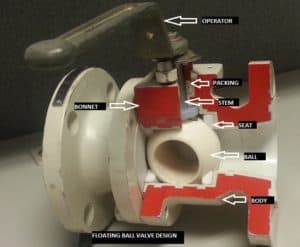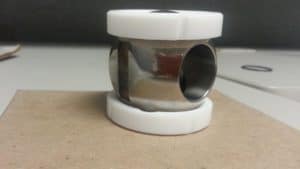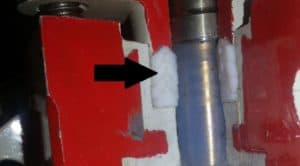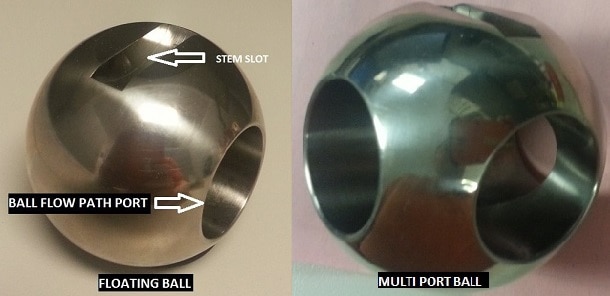Floating Ball Design Vs Trunnion Mounted Ball Design
Ball valves are a type of piping equipment that shuts off or controls the flow in a pipeline by using a hollow sphere and round seats held in a valve body. There are two basic technologies for the design of ball valves, floating ball design and trunnion mounted ball design.
 The major components of a ball valve include:
The major components of a ball valve include:
Valve body – A pressure vessel that contains the components needed to control or shut off the flow through a pipe. It is designed to connect two or more sections of pipe or tubing to each other.
Ball – A sphere with a flow path (hole or tunnel) through the center of it and a connection point for a shaft to rotate it.
Seats – Round donut-shaped discs that form a seal between the body and ball.
Stem – A shaft that connects the internal ball to the outside of the valve to facilitate rotation of the ball.
Packing – Flexible seals that fit around the shaft and prevent the media traveling through the valve from escaping externally.
Bonnet – The part of the valve body that houses the stem and packing.
Operator or Actuator – An external device designed to rotate the stem of the valve. This can be a lever, a gear, a motor-operated gear (electric actuator), or a pneumatic/hydraulic actuator.
Floating Ball Design
 A floating design ball valve sandwiches the hollow ball between two or more cupped seats that form a tight seal between the body and the ball at the inlet and outlet ports of the valve body.
A floating design ball valve sandwiches the hollow ball between two or more cupped seats that form a tight seal between the body and the ball at the inlet and outlet ports of the valve body.
The ball is rotated (usually 90 degrees) by a shaft that protrudes outside of the valve body and is connected to some form of operator. For this reason, most ball valves are referred to as quarter-turn valves. This shaft is not rigidly attached to the ball in order for the ball to pivot on the end of the shaft as it rotates on the axis of the ball. This is usually accomplished with a slot on top of the ball, perpendicular to the ball’s flow path. The cupped portion of the seats cradle the ball prevents it from moving down in the valve body.
 The valve packing prevents the media from escaping the valve body through the stem opening in the bonnet. The most common type of packing today is chevron v-ring type packing. If you look at the cross section profile of this packing, it resembles the letter “V”. The outer diameter of the packing matches the bore of the bonnet. The inside diameter matches the outer diameter of the stem. Multiple rings of this packing are stacked on top of each other and the stem is inserted through the packing. A packing gland on top of the bonnet pushes down on the top of the “V” and causes the packing to expand and seals against the stem and bonnet.
The valve packing prevents the media from escaping the valve body through the stem opening in the bonnet. The most common type of packing today is chevron v-ring type packing. If you look at the cross section profile of this packing, it resembles the letter “V”. The outer diameter of the packing matches the bore of the bonnet. The inside diameter matches the outer diameter of the stem. Multiple rings of this packing are stacked on top of each other and the stem is inserted through the packing. A packing gland on top of the bonnet pushes down on the top of the “V” and causes the packing to expand and seals against the stem and bonnet.
When the ball is in the closed position, the flow path in the ball is perpendicular to the flow path in the valve body. The solid parts of the ball covers both upstream and downstream cupped seat openings. The pressure in the upstream pipe pushes against the solid part of the ball which moves on its pivot point and is forced tightly against the downstream seat. This shuts off flow.
As the operator rotates the ball from the closed position, the ports in the body in relation to the ports in the ball create a variable size orifice which, as it gets larger, will increase the flow through the pipe. When moving from open to close, this orifice gets smaller and decreases flow.
Floating ball design valves are the most economical valves, but are limited by the amount of pressure the seats can handle.
Trunnion Mounted Ball Design
 The trunnion design ball valve works nearly the same way as the floating ball except the seats are spring loaded against the ball and the ball does not pivot. The ball only rotates on its axis in this design.
The trunnion design ball valve works nearly the same way as the floating ball except the seats are spring loaded against the ball and the ball does not pivot. The ball only rotates on its axis in this design.
In the trunnion mounted ball valve, the ball utilizes a second shaft and bearing on the bottom of the ball. This stem or “post” holds the bottom of the valve in place. The top of the ball is not slotted and the upper stem is rigidly attached to the ball. This prevents the ball from moving into the downstream seat.
Since the ball does not move into the seats, the seats must move towards the ball. Springs behind the seat push them tightly into the ball in order to make the seal.
Trunnion valves are very effective at sealing off very low pressures that would not be strong enough to move a floating ball into the downstream seat. They are also required on large diameter valves and high-pressure valves. The reason for this is the contact area of the seats in a floating ball is relatively small. From physics, we know force = Pressure x Area. The force on the downstream seat in a floating ball is derived from the process pressure in the upstream pipe pushing on the solid area of the ball in the closed position. If the pressure is high or the area is large, the downstream seat will be destroyed.
The tradeoff is that trunnion valves are much more expensive than floating ball designs.
Both floating ball and trunnion designs are available as multi-port valves by using elaborate flow paths in the ball and additional ports in the body.
Are you looking for ball valves for your facility? Our team has years of experience in selecting the perfect valve for any application. Contact us today to discuss your specific valve needs!
How Cross Can Help
Cross Company Process Solutions is an authorized Solutions Partner, recognized Systems Integrator, Manufacturer’s Representative, and value-added Distributor for process manufacturers in a wide range of industries. With our focus on systems integration, process instrumentation, valves and valve repair, and many other full solutions, we can ensure your facility is running the way you need it to. Check out our products, services, and solutions to see how we can add value to your process.
As members of the Control System Integrators Association (CSIA) as well as certified solutions partners for ABB, Honeywell, Rockwell, Siemens, and VTScada, Cross Company has the the experience and expertise to optimize your process. Contact our Process Solutions Group today to learn more or to get started.





